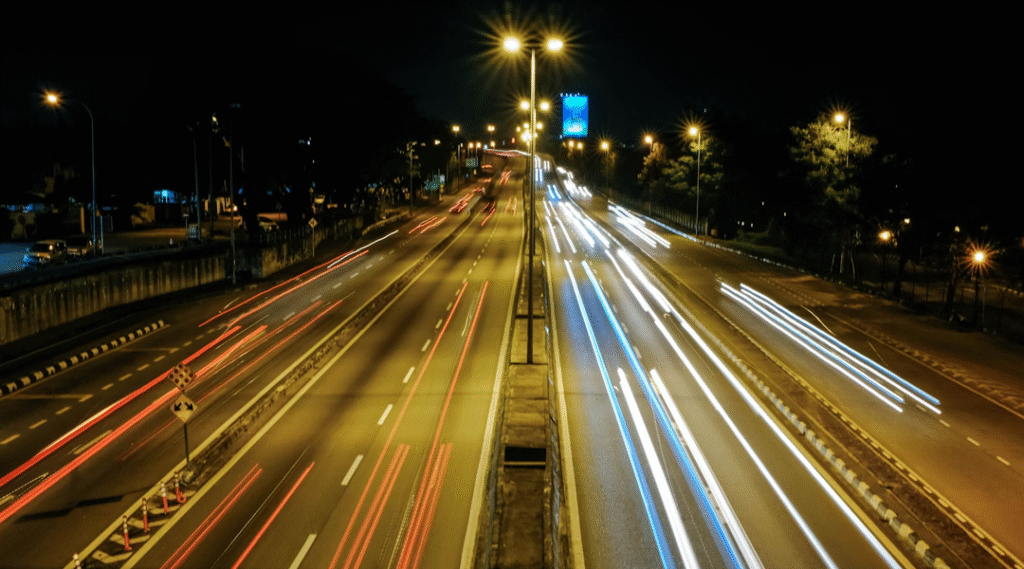As cities worldwide face increasing congestion, safety concerns, and environmental pressures, smart traffic systems have emerged as vital solutions. From Asia’s meticulously coordinated networks to North America’s pioneering adaptive controls, these real-world implementations reveal both successes and lessons learned. Below, we revisit five landmark projects—highlighting their approaches, outcomes, and critical insights for any city pursuing smarter streets.
1. Singapore’s GLIDE: Seamless Signal Synchronization
Overview: Singapore’s Land Transport Authority developed the Green Link Determining (GLIDE) system to continuously optimize traffic lights across the island. By drawing data from embedded road-loop detectors, GLIDE adjusts green‑light durations dynamically and coordinates adjacent intersections to form “green waves.”
Outcomes:
- Reduced Delays: Average intersection waiting times dropped by over 10%.
- Smoother Flow: Vehicles experience fewer stops on major corridors, cutting fuel consumption and emissions.
Why It Works: Real‑time data feeds into a city‑wide control center, enabling system‑wide tuning rather than isolated adjustments.
2. Barcelona’s Smart Streetlights and Traffic Lights
Overview: As part of its long‑running Smart City initiative, Barcelona outfitted more than 10,000 streetlights with motion and ambient‑light sensors. Building on the energy savings achieved, the city is now piloting AI‑enhanced traffic signals that use live camera feeds and historic traffic patterns to predict peak flows.
Outcomes to Date:
- 30% Energy Savings: Adaptive lighting cut electricity consumption significantly.
- Early Pilot Gains: Initial tests of AI signals show up to a 15% reduction in peak‑hour congestion on test corridors.
Why It Matters: Barcelona’s phased approach—first saving energy, then shifting to congestion management—demonstrates the value of incremental rollout.
3. Amsterdam’s Data Privacy Hurdle
Overview: Amsterdam invested heavily in central monitoring, deploying cameras and sensors to inform traffic operators. Plans to introduce GPS‑enabled smart signals in early 2025 stalled after data‑protection authorities raised concerns over potential personal tracking and opaque data‑sharing agreements.
Key Lesson: Privacy safeguards must be baked in from project inception. Amsterdam’s retreat underscores the need for transparent policies, rigorous anonymization, and community engagement.
4. Los Angeles’s ATSAC: A Legacy of Adaptation
Overview: Since the 1960s, Los Angeles has refined its Automated Traffic Surveillance and Control (ATSAC) system. Today, more than 4,500 intersections feed real‑time detector data into an analytics engine that continuously tweaks signal timings across the urban grid.
Long‑Term Impact:
- 10% Faster Commutes: Persistent reductions in rush‑hour travel times.
- Scalability: Decades of incremental upgrades show that legacy systems can evolve rather than be scrapped.
Why It Endures: A dedicated operations team and steady funding for sensor maintenance keep ATSAC responsive and reliable.
5. Comparative Insights and Best Practices
- Data-Driven Control: Whether through loop detectors, cameras, or GPS, continuous vehicle counts are non‑negotiable for effective signal optimization.
- Phased Deployments: Pilots in select districts or corridors allow for performance validation and public buy‑in before city‑wide rollouts.
- Privacy by Design: Early collaboration with data‑protection authorities, clear data‑use policies, and built‑in anonymization prevent costly project reversals.
- Sustainable Operations: Beyond hardware installation, success hinges on analytics teams, maintenance budgets, and regular system tuning.
- Cross-City Collaboration: Sharing tools, standards, and lessons—through international consortia or open‑source projects—accelerates progress and cost‑efficiency.
Final Thoughts
Smart traffic projects from Singapore to Los Angeles illustrate that, with the right blend of real‑time data, adaptive algorithms, and thoughtful governance, cities can dramatically improve mobility, safety, and sustainability. Yet challenges around privacy, funding, and scale remain. By learning from these trailblazers—emphasizing incremental pilots, robust data protection, and ongoing operational support—urban planners can craft resilient, citizen‑focused traffic systems ready to meet tomorrow’s demands.
All articles on this special edition-SMART TRAFFIC:
(#1) What Is Smart Traffic? A Complete Beginner’s Guide
(#2) The Technologies Behind Smart Traffic: From IoT to AI
(#3) Reimagining Urban Roads: Smart Infrastructure in Action
(#4) How AI and Big Data Are Revolutionizing Traffic Management
(#5) Smart Traffic Meets Autonomous Vehicles: A Symbiotic Future
(#6) Smart Traffic Benefits and the Roadblocks Ahead
(#7) Global Smart Traffic Projects: Key Takeaways for Urban Mobility
(#8) Who’s Leading the Smart Traffic Revolution?
(#9) The Future of Smart Traffic: Key Trends for 2025 and Beyond
(#10)Building Ethical, Legal, and Secure Smart Traffic Systems
As for in-depth insight articles about AI tech, please visit our AI Tech Category here.
As for in-depth insight articles about Auto Tech, please visit our Auto Tech Category here.
As for in-depth insight articles about Smart IoT, please visit our Smart IoT Category here.
As for in-depth insight articles about Energy, please visit our Energy Category here.
If you want to save time for high-quality reading, please visit our Editors’ Pick here.



